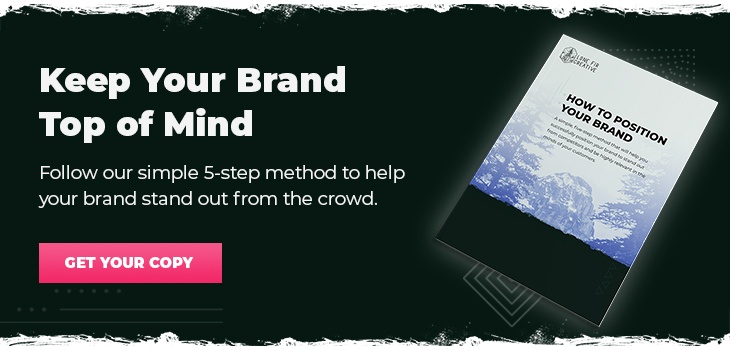Let's face it, as Google updates its search algorithm, cracking the "SEO code" continues to get more complicated. So, if your life's work isn't dedicated to being an SEO guru, like Brian Dean of Backlinko or Rand Fishkin (formerly of Moz) at Sparktoro, then what are the basic SEO strategies you need to know when writing SEO-friendly content?
In this blog, we’ll go in-depth covering the four basics needed to write an SEO-friendly blog post that optimizes your content to have a better chance of showing up in search results.
What Does "SEO-Friendly" Mean?
Let's take a step back and get the 30,000-foot view for a minute.
If you have a good content strategy in place you should already be clear about the goals for your blog content. It’s safe to assume that part of the goal is to 1) create quality content that’s valuable to your audience and 2) increase website traffic (which should result in more revenue.)
The point is that your audience is typing main keyword questions in their preferred search engine (likely Google, Bing or Yahoo) and seeking high-quality answers. You know you have the answers to help them, but how are you going to make sure they find the solution from you instead of a competitor?
There's a long list of SEO best practices that range from baseline 101 to advanced mad scientist. For your blog content to have a fighting chance, you'll need to make sure you meet these four basics so that Google deems it "friendly" to their search engine, while simultaneously matching the implied search intent.
Four Basics of SEO-Friendly Blog Posts
- Content Relevance and User Intent
- Heading, Subheading, Meta Description and Title Tag
- Linking and Readability
- Avoiding SEO Penalties
- Bonus: SEO Review Checklist
1. Content Relevance and User Search Intent
Marketers ruin everything. Am I right?
Early on, it was all about the quantity of content you could produce. Bloggers would crank out as many 500 to 800-word articles as they could about a topic because it was new territory.
People were searching for useful information, but there wasn’t much out there. So, if you wrote enough content early on, you would experience high organic traffic numbers.
Fast forward to today: keyword stuffing is easily detected and Google's algorithm is sophisticated enough to capture the intent of a query and the relevance of results. Therefore, writing quality content is of utmost importance.
Let's think about Google real quick.
Their main goal is to provide users with the most relevant search results as quickly as possible.
Why wouldn't you want to do the same?
Example: You perform a Google search for "how to do keyword research?"
The search engine results page (SERP) provides several articles about keyword research, so you click on the first one only to find a fluffy article promoting a fancy research tool that requires a monthly subscription.
Not helpful. A search intent flop.
This, in turn, creates a poor user experience that Google would like to avoid. So, that article will start to decrease in rankings, while more robust, quality content wins because it satisfies the relevancy and intent.
Takeaway: Think about the user's search intent. Put yourself in their shoes and write high-quality content that they'll find valuable. Doing so will position you as an expert worth trusting, optimize the guidance of your content strategy and encourage people to come back to you next time.
2. Heading, Subheading, Meta Description and TitleTag
Warning: this is about to get really tech-y.
Headings and Subheadings
Gurus like Yoast (if you haven't tried it yet, their WordPress plugin is a solid starting point for SEO tips and strategy) describe headings and subheadings as "signposts" for the reader. They allow readers to easily keep track of their place while also improving accessibility. If your article is easy to read, the user will be happy, which makes Google happy.
More technically speaking, headlines follow a specific HTML structure. The format starts with a title tag, then a header 1 (H1 tag) and goes down to subheadings 2 - 6.
The title tag denotes the title of your page, not the title of your blog. This is an important distinction many businesses and bloggers alike miss.
The title of your blog post needs a header 1 tag. The following section requires a header 2, and any subsections will be your tags 3-6 respectively. Think of heading tags like Russian nesting dolls. Topics that all relate to a big idea with nest within an H2 tag, and when you move on to a new big idea, you start a new H2 section.
Also, keep in mind that you don’t really want to go further than an H4, and even then only sparingly. The ideal level of tags is a variety of H2s and H3s, otherwise, your page structure can get confusing.
Example:
- <h1> Coffee Is Better Than Tea
- <h2> Why We Think Coffee Is Better Than Tea
- <h3> The smell of fresh coffee
- <h3> Going to coffee shops
- <h3> The taste of coffee
- <h2> Different Ways of Making Coffee
- <h3> Espresso
- <h3> Pour over
- <h3> French press
- <h2> Why We Think Coffee Is Better Than Tea
You get the idea. And if you think tea is better than coffee, please don't be offended by our hypothetical example.
Meta Description
This is a short, 155-character snippet that describes what the user can expect to get from your content.
Note: you may find yourself tempted to write this description using a technique known as keyword stuffing. Focus instead on conducting quality keyword research, so when the search engine displays this summary directly underneath the page link, it quickly answers the questions around the user search intent.
If you hadn’t already noticed, you encounter meta descriptions daily (see below).
In short, the meta description is what causes someone searching on Google to actually click your link.A catchy post title style description won’t hurt your chances either.
Here are a few things to consider when writing your meta description:
- Use the 155 characters allotted. Try not to go over!
- Include your main keyword in the description.
- Don't forget to include useful information and a call to action.
- Make sure the description aligns with the content on the webpage. Remember, Google desires a positive user experience. So if your description isn't accurate or leads the user in the wrong direction, that's problematic.
Bonus: Alt tags
This is like the game-changing cheat code you had in early childhood that gave you a clear advantage. Then you told your friends, and it leveled the playing field!
A crucial part of SEO that often gets overlooked is optimizing media like images and videos for accessibility.
The alt tag, or alt text, is a description of what the image is. The main reason for this is that screen readers, a tool that improves the user experience for the visually impaired, require this information to accurately describe your web page. They scan the page and read the content for the user, including image alt text.
So, when writing an alt tag, be sure to describe what the image is. Use keywords appropriately, and with context (keyword stuffing is still a bad idea; don't try it here either.)
3. Linking and Readability
Link Juice and Domain Authority
Links are a crucial piece of the puzzle that you can't afford to overlook.
What was formerly known as "link juice" is now known as link equity (I still prefer link juice though). It's a search engine factor based on the theory that links pass authority from one page to another.
Inbound links, also known as backlinks, occur when another website links back to your site. Many writers do this when writing blog posts for example. (More on this later.)
Google views inbound links (also called backlinks) as an indicator that your site has high-quality content, making these links one of the most important elements in search engine optimization.
Next, domain authority (DA) is a metric that was created by Moz to show the ranking power of a domain on a scale of 0-100. Think of this metric as your website's reputation according to Google.
For example, a brand new website will have a domain authority of 0. Google doesn't know yet if you're trustworthy or if the content on your site is credible.
A website like Forbes.com, for example, has a DA of 95!
So you may be wondering, "how do I improve my domain authority?"
Great question. We'll cover some of that below, but first, you should measure your current domain authority with this free Moz tool.
Internal Linking and External Links
Internal linking is different from the backlinks process mentioned above and is relatively simple to do. It’s a rather underrated tactic in our opinion. How to do it? In each post, add three to five links to older posts. It's that easy.
And don't forget to go back through your other related blog content to find a fitting place to link to your new ones!
External links are hyperlinks that link to another source, or when someone else links back (backlink) to your social media, blog content, etc. Remember earlier when we referenced other people talking about you or referencing your reputation? This is the tricky part.
Here's what top SEO experts like Moz say about external links. "They are the most important source for ranking power. Unlike internal linking, external links are valued more because search engines consider them to be third-party votes." Ultimately, quality content at its finest!
According to Niel Patel, the smartest way to get more links to your website are:
- Create authoritative, useful, and trustworthy content
- Improve the strength and popularity of the brand
- Continually advertise, promote, and get PR
- Promote good website content and be sure it gets in front of the right audience
And if you're looking for a secret vault of tactics to use, we'd recommend watching all 14 minutes of Brian Dean's link-building strategy on BacklinkoTV.
Takeaways:
- Internal linking should be a standard part of your search engine optimization strategy.
- Writing quality content that earns reputable backlinks will drastically impact your ranking power.
Readability
Your piece of content should be skimmable.
No, this doesn't mean boring. Your target audience will appreciate skimmable content because it offers a better user experience. Your information becomes not only easy to navigate but easy to digest as well. Readers can quickly find the information they’re looking for.
Scanning content is the norm. Even if it's the most compelling piece, the average reader will only read 20%-28% of a piece of content. Yikes!
So, it's more important than ever to format your content in a scan-ready layout. Here's how you can improve that skimmable factor for easier readability:
- Bold highlights grab the reader's attention. Highlight important takeaways that should stand out and use italics to emphasize or create conversation.
- Short paragraphs help the reader advance through the content quickly. Who doesn't like that feeling?
- Bullet points and lists create easy-to-read information instead of long paragraphs. Think Cat in the Hat vs. an advanced quantum physics textbook.
4. Avoiding SEO Penalties
Search engines have rules. Whether they are written rules, loose guidelines or laws, the reality is that you have to play the game if you want to win.
Common penalties can include surface-level issues like site speed, bounce rate, image sizes and duplicate header tags, as well as more complicated and technical aspects about your backend website structure and sitemap.
Thankfully, there are a variety of tools and technology that will help guide you through this process so that you aren't unknowingly penalized for "rules" you didn't know you were breaking.
Helpful tools:
- Light House Audit: Google Chrome's Lighthouse Report diagnoses precisely what you need to know about how your website is performing. Here's how to run a Lighthouse Report.
- SEMRush: this powerful tool gives you the ability to run several reports and audits to better understand the performance of your current SEO efforts and how to improve.
- Moz: this keyword tool helps you pinpoint your keyword strategy and the long-tail keywords and related keywords needed to bolster your content.
- Yoast SEO plugin for Wordpress: This plugin guides you through your on-page SEO strategy. It's simple and incredibly accurate.
Oh, one more thing to consider...
Mobile.
Optimizing content for the mobile experience is now a baseline. More content is viewed via mobile than desktop these days. So, if your content doesn't have a positive user experience, Google will devalue (a.k.a. penalize) the content.
If Google is devaluing the content, then your content is far less likely to appear in a search.
5. Bonus SEO checklist
All of this can get overwhelming quickly, so we'll share the checklist we use for our content.
This isn't the only way, but it is a way that has helped drastically improve our organic traffic this year.
Give it a try!
1.) Outline: confirm and fill out the following at the top of the page
- {Title of Blog Post}
- {Primary Keyword}, (search volume | competition)
- {Secondary Keyword}, (search volume | competition)
- {Word Count} Target Range
2.) Make sure the post title is evergreen appropriate
Some examples of evergreen titles are:
- How to...
- All About...
- The Ten Things You Need...
- The Comprehensive List...
Ensure structure follows proper evergreen content formatting
3.) Primary Keyword/ Secondary Keyword
- Ensure the primary key phrase is in the title, first paragraph, and last paragraph.
- Outside of the title, first paragraph, and last paragraph (explicitly reserved for primary keywords), integrate secondary keywords into the body of the text.
- Keyword density - use a keyword research tool to identify the primary keyword throughout the page. The number of times you use it isn’t important, but consistent and applicable use of it is crucial. And don't stuff it, just use it where it fits naturally.
Writing quality content to increase traffic isn't as cut and dry as it was long ago. Search engines change quickly, and more factors than ever before are required in a strong SEO strategy.
At Lone Fir Creative, we can help with that. Let's talk. Schedule a strategy session today, and we'll help you get where you want to go.








